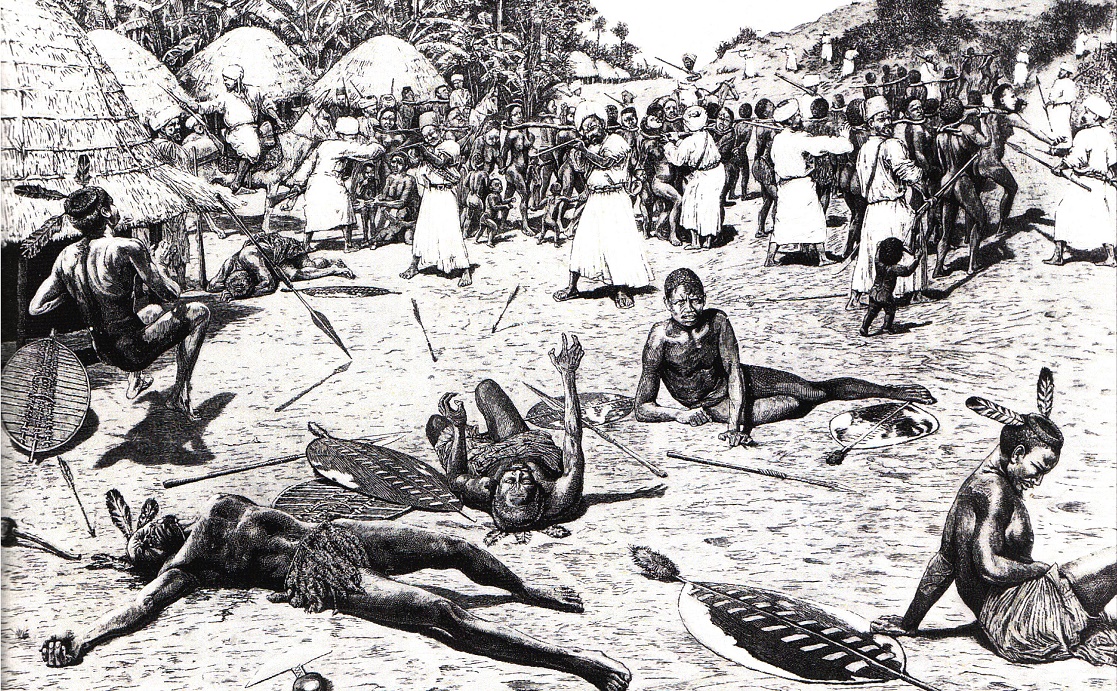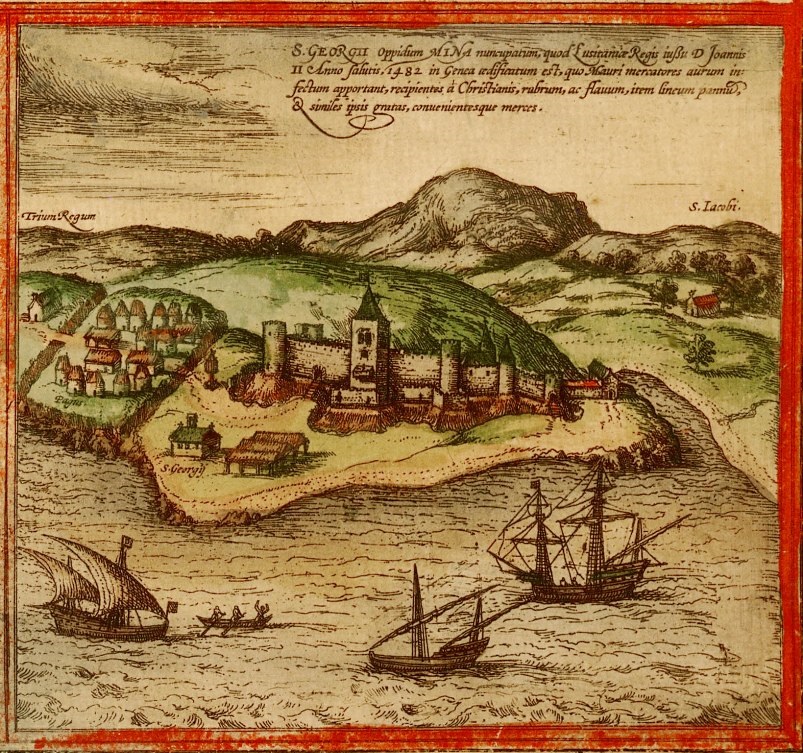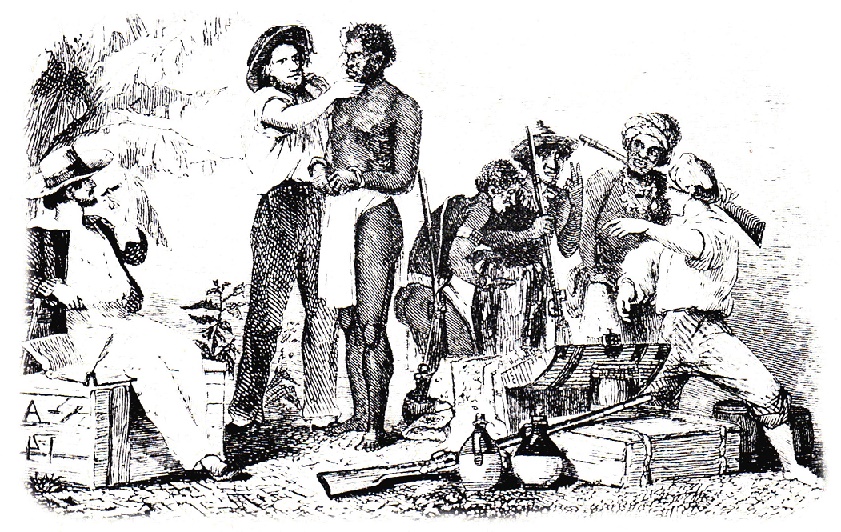
Captured

Introduction
In the early days of the slave trade, white slave traders (called `blackbirders') simply landed anywhere on the African coast, chased after Africans and caught them. This was called Lesser Pillage.
Later, the British traders used middlemen called slave 'factors'. The factors made agreements with local African rulers, who declared war on their neighbours, took prisoners of war, and then sold these captives as slaves to the factors. This was called Grand Pillage.
After you have studied this webpage, answer the question sheet by clicking on the 'Time to Work' icon at the top of the page.
Links:
The following websites will help you research further:
Taking slaves:
•
The capture of Kunta Kinte as depicted
in the TV series Roots (1977)
• A tour of
Elmina factory/castle (CNN)
1 Ottobah Cuguano, Thoughts on the Evil and Wicked Traffic of Slavery (1787)
Captured into slavery at the age of 13, Ottobah Cuguano was first taken to a plantation in the West Indies. He was bought there in 1772 by an English merchant, who took him to England and gave him his freedom, after which he worked as a servant to a fashionable London artist. In the 1780s, Cuguano became one of the leaders of the Abolitionist campaign in Britain.
I had become friends with some other children, and we were some days too bold in going into the woods to gather fruit and catch birds...
One day we went into the woods as usual, but we had not been above two hours, before our troubles began, when several ruffians came upon us suddenly.
Some of us tried in vain to run away, but pistols and cutlasses were soon produced, threatening that if we tried to move we should all lie dead on the spot.
One of them pretended to be more friendly than the rest, and said he would speak to their lord to get us clear, and desired that we should follow him; we were then immediately divided into different parties, and were driven after him.
We were soon led out of the way which we knew, into slavery.
2 Major Dixon Denham, 1823
Denham was a British soldier, explorer and adventurer in the mould of Clive – 'he was the kind of man who must have adventure or he rots', brave, but also domineering, and sometimes unpleasant.
On attacking a place it is the custom of the country instantly to set fire to it, and as they are all made of straw huts only, the whole is soon devoured by the flames.
The unfortunate inhabitants run quickly from the fire and fall immediately into the hands of their no less merciless enemies who surround the place; the men are quickly massacred, and the women and children lashed together and made slaves.
3 A Slave Coffle in the 19th century
Captured Africans were taken to the coast in lines called collies from the Arab word cahla, meaning 'a caravan') They would be whipped and made to run about 20 miles a day .

4 A Slave Raid
The slave traders in this picture are Arabs (they are the ones dressed in white robes).
Which Africans are the slave traders NOT taking? Suggest reasons for their choice.

5 Major William Gray, 1821
William Gray was a British soldier and explorer who led a failed expedition into West Africa trying to find the River Niger.
One young woman had (for the first time) become a mother two days only before she was taken, and her child, being thought by her captor too young to be worth saving, was thrown by the monster into the burning hut, from which the flames had just obliged the mother to retreat.
6 Grandy King George, 1773
Slave traders sometimes took pawns (hostages) In order to get a better deal. This extract is from a letter from a Calabar caboceer (local ruler) to a Liverpool trading company.
I hope you and merchant Black won't stay away, or the other merchants of Liverpool that has a mind to send their ships.
They shall be used with nothing but civility and fair trade. Other Captains
may say what they please about my doing them any bad thing, for what I did
was their own faults, for you may think, sir, that it was very annoying to
have my sons carried off by Capt. Jackson .. . And to annoy us more the time
we were firing at each other they hanged one of our sons from the yard-arm.
Your best friend, Grandy King George
Interrogating the letter:
From the clues in the letter, can you work out what had
happened?
Click here for the story
Suggest reasons why – after British slave traders had hanged his son, the
Grandy was still urging more British slave traders to come to do business with him.
7 Dutch West India fort at Elmina
As the slave trade grew, the trading companies set up fort-like prisons called 'factories', in which they collected and detained the captured Africans until they could be found a ship to take them to the West Indies and America.

Introduction (continued)
By 1800, British slave ships sailed to the African coast and bought their cargo of enslaved Africans from a factor, or direct from an African ruler.
8 Captain Crow's estimate of the price of a slave at Bonny Bay, now Biafra, in 1801
Captain Crow was a good slave trader, who treated his cargo well. When he docked in the West Indies, many of his former 'passengers' went to the docks to say hello!
As the selling price of
an enslaved Afrcan was only about £35 in America, it is possible that Captain Crow was exaggerating.
About 100 metres of different types of cloth, forty-five handkerchiefs,
One large brass pan, two muskets,
Twenty-five kegs of powder, one hundred flints;
Two bags of shot, twenty knives;
Four iron pots, four hats, four caps,
Four cutlasses, six hundred bunches of beads, fourteen gallons of brandy
These articles cost about £25, so that the reader will see we do not get Negroes (as many have supposed) for nothing.
9 Haggling over the price

Interrogating the letter:
The slaver is looking at the man's teeth, as one would when buying a horse.
What does this tell you about the slave trade?